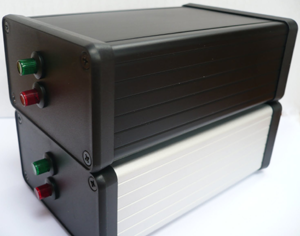This review page is supported in part by the sponsors whose ad banners are displayed below |
 |
 |
|
 |
Towards the end of the review John announced that his products can now trickle charge whilst listening without any sonic penalty. Two illuminated push-button switches supplant the toggle and LED. The top green LED switch is for power on/off; the bottom red LED switch is for charger on/off.
Since the battery charger can accept a 5V power supply, the user can also charge from a spare USB port with the correct USB cable (type A male to 2.1mm plug). Run time from a fully charged battery if disconnected completely from a power source is reportedly a solid 20 hours.
|
|
A key feature of the PCM5102 chip are its two digital filter options - the more common FIR (finite impulse response) or brickwall filter; and the IIR (infinite impulse response) low-latency filter. With all FIR filters used in the majority of digital gear, pre echoes occur prior to each transient. Since those ahead-of-the-event echoes don’t exist in nature, this may partially explain why many audio enthusiasts dislike digital music and feel it just doesn’t sound right. With an IIR filter the energy contained in the pre-ringing is delayed until after the impulse peak has passed. However this post ringing now contains more energy. That can introduce phase distortions at the upper band of the audio spectrum. Nonetheless this is generally considered more acceptable to the human ear-brain since post echoes do occur in real life. We’re wired to accept those echoes as natural.
|
|
|
Incidentally NOS non-oversampling DACs avoid pre/post ringing altogether if they do without a digital filter. This is probably why they can sound so natural to many. However NOS DACs can have other problems. Think massive aliasing distortion and premature HF rolloff which may or may not bother you. I have heard good and poor implementations of any of the above. I simply cannot declare one method superior to another. Nevertheless John has chosen the low-latency IIR filter primarily to emulate the claimed more natural sonics of NOS-style DACs minus their aliasing distortion.
|
|
| |
 |
As with the JKSPDIF, M2Tech’s hiFace drivers available on their website are required for the JKDAC32 to function on Windows and OS X. Download and installation were a snap. The JKDAC32 handles 32-bit/384 kHz if you run with the Young driver. According to John the hiFace actually uses a 32-bit pipeline but is limited to 24-bit/192kHz by its own driver. |
|
When using the Young driver—written for M2Tech’s Young DAC—it passes the full 32 bits at 384kHz. Cool as that might sound, good luck finding much 32bit/384kHz music. Most studios seem to be sticking to 24/44.1kHz or 24/48kHz releases at present. While I couldn’t find any 32/384kHz files for this review, this feature does make the JKDAC32 somewhat future proof at least for the next few years.
|
|
|
I did try both hiFace and Young drivers with the JKDAC32 and JKSPDIF. Even with 16/44.1 material the Young was slightly smoother and a tad more refined. I can only speculate that this driver is a superior piece of software perhaps more efficient at passing a digital signal. Apart from one idiosyncrasy the JKDAC32 functioned perfectly. As noted in the instructions, the on/off switch occasionally required a few extra quick flips before passing sound. According to John this initialization glitch affected older models like my review loaner. It's no longer an issue with current production.
|
 |
During the review I played all manner of 16bit/44.1kHz up to 24bit/192kHz material on my HP Windows 7 laptop using J. River Media Center 17 and JPlay. The latter is a stripped-down player program that has soundly confirmed my belief that in computer audio everything makes a difference. Bits are definitely not bits. JPlay sounds even better in its latest version, which includes plug-ins for J. River, Foobar and iTunes. I’ll have more to say about JPlay in another review. For now you download a free demo version and see for yourself. Since I still had the recently reviewed Calyx 24/192 for a few more days before it was due to be returned, I briefly compared the two DACs. Whatever playback software I used, all playback was bit perfect (i.e. without any upsampling or other digital tomfoolery).
|
 |
  |
 |